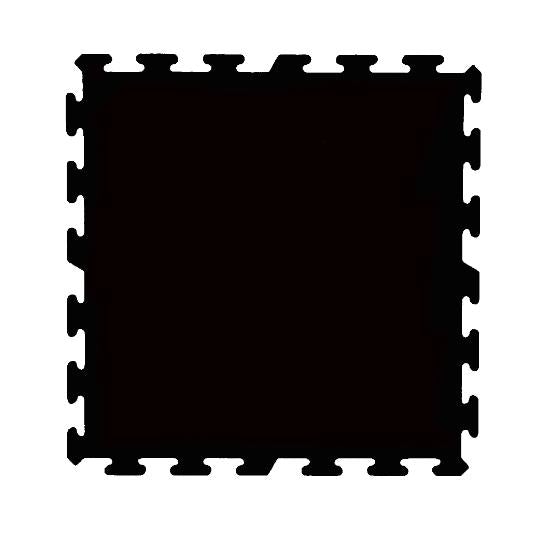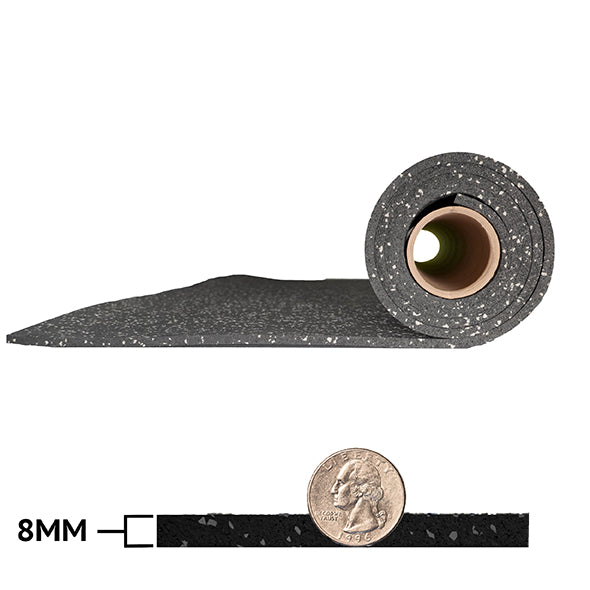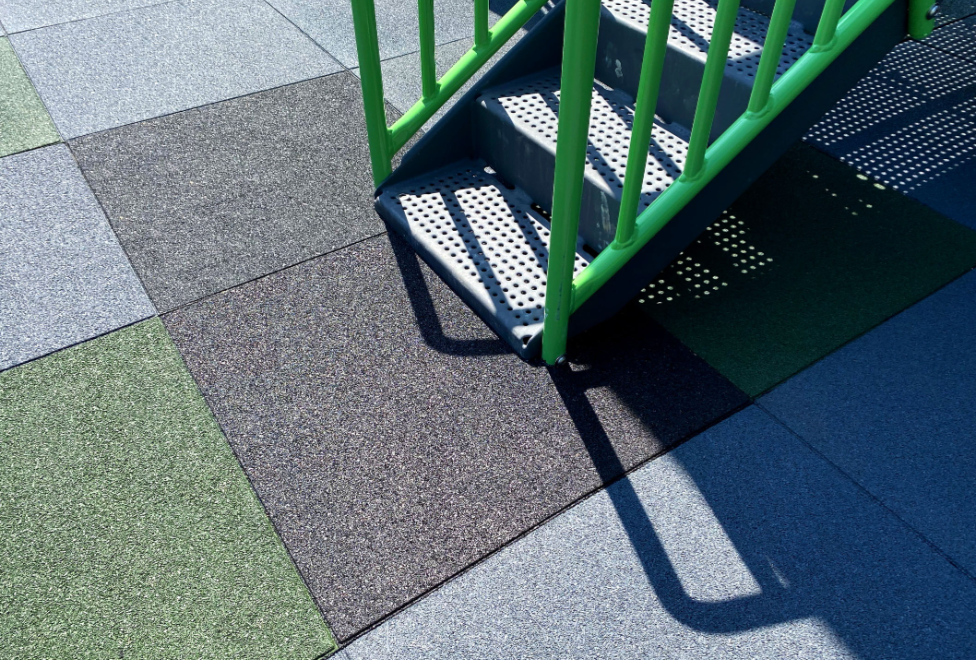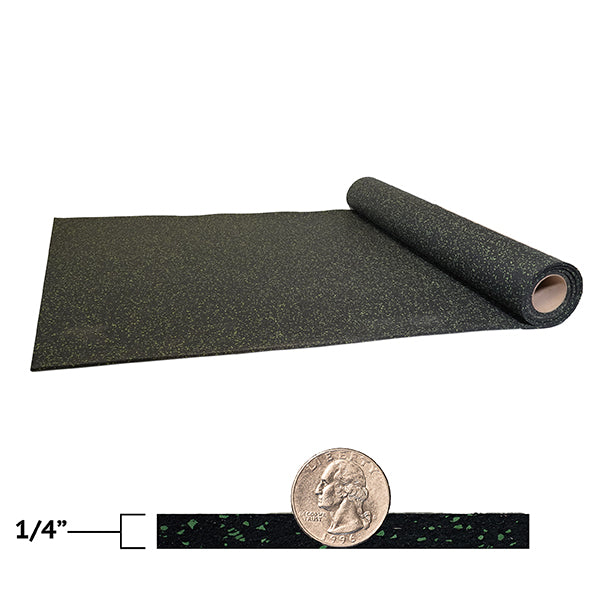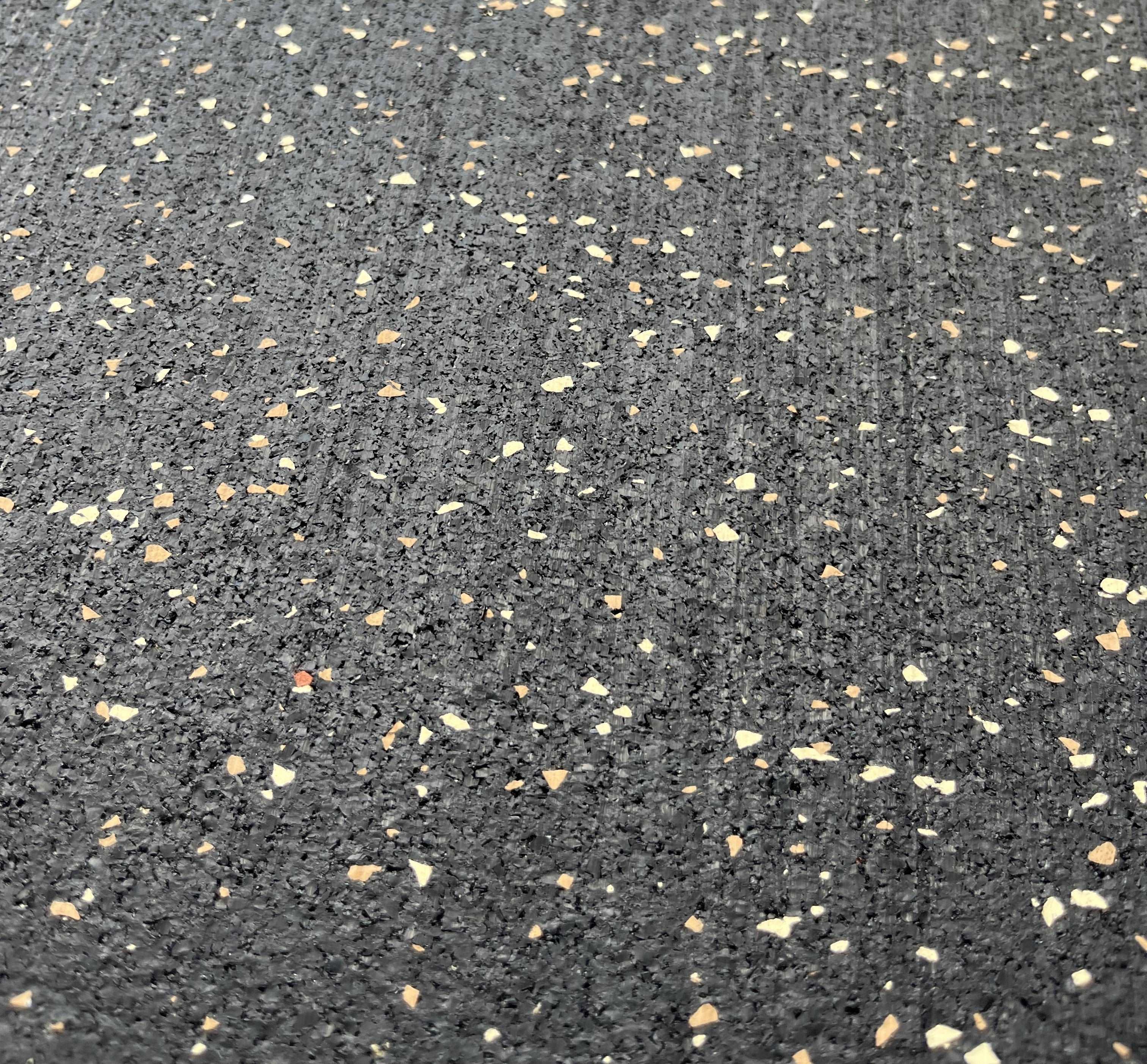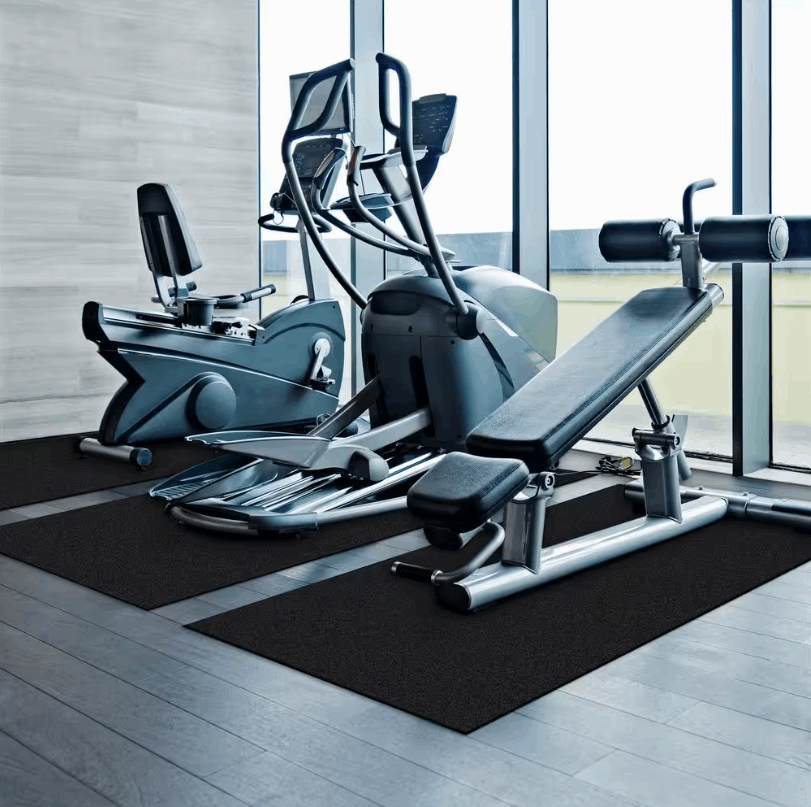Installation Accessories
Product Details
Durable, sleek, and stylish. Our Dynamic 3/8" Thick Pre-Cut Rubber Rolls for Fitness Areas are perfect for tough flooring solutions. These rubber rolls provide excellent protection from weight drops and safeguard your subfloors. With these options, you can pick and choose the best fit for any fitness project, ensuring both durability and style.
Rubber rolls are great to use for the following:
- Commercial Gyms
- Work areas
- Home Gyms
- Ski Lodges
- Doggy Daycare and Pet Kennels
- Garage Gyms
- Military Bases
- Ice Rinks
- High School/College Weight Rooms
- Garages
- Warehouses
Tech Specs:
- Thickness:3/8" (9mm)
- Weight:Approximately 2.4 lbs per sqft
- Sizes: 4'x15', 4'x20', 4'x25', 4'x30', 4'x35', 4'x40', 4'x45', and 4'x 50'
- Coverage:4'x10' covers 40 sqft,4'x15' covers 60 sqft, 4'x20' covers 80 sqft, 4'x25' covers 100 sqft, 4'x30' covers 120 sqft, and 4'x50' covers 200 sqft
- Lead Times:Orders ship out in ~ 1 week or less. Orders over 2000 sqft may take a little longer.
- Origin: Made in the USA, By USA Employees.
- Color Disclaimer:Actual color may vary slightly from on-screen representation and samples. Please contact sales for additional information.
- Confetti Disclaimer: We are unable to confirm color saturation and content from roll to roll. This product is made from the trimmings of all colors and rubber products. Please contact our Customer Service Department for additional information.
Highlights
| Anti-slip and resistant to indentations. |
| Pre-cut rolls give you options that fit your planning. |
| Noise and vibration absorbent. |
| 5-year warranty |
Maintenance
One of the best things about using recycled rubber is that maintenance is extremely easy! Simply sweep or vacuum any loose dirt off matting and the occasional damp mopping with a mild cleaning solvent is all you would need. Do not use any oil base solvents or cleaners.
Best Sellers
Featured Deals
FAQ's
Rubber flooring is known for its durability, making it a popular choice for a variety of commercial and residential applications. The durability of rubber flooring can vary depending on several factors such as the quality of the rubber, the thickness of the material, and the type of environment it is installed in. Generally speaking, rubber flooring is highly durable and can withstand heavy foot traffic, abrasions, impacts, and moisture. It is also resistant to stains, chemicals, and UV rays, which can help prolong its lifespan. Additionally, rubber flooring can provide a slip-resistant surface, making it a safe choice for areas that are prone to slips and falls. Overall, the durability of rubber flooring makes it a reliable and long-lasting choice for many applications, including home gyms, playgrounds, and commercial kitchens. However, it's important to note that proper installation and regular maintenance can also play a role in ensuring the longevity of the flooring.
The cost of rubber flooring can vary depending on several factors such as the quality of the material, thickness, color, texture, and the size of the area to be covered. On average, the cost of rubber flooring can range from $1 to $15 per square foot. Basic black rubber tiles or rolls can be on the lower end of the price range, while higher-end options such as colorful or textured rubber flooring can be more expensive. In addition to the material cost, installation, and labor costs can also add to the total cost of rubber flooring. DIY installation is possible for some types of rubber flooring, but for larger installations or complex layouts, professional installation is recommended. Overall, the cost of rubber flooring can be higher than other flooring options such as carpet or vinyl, but its durability and long lifespan can make it a cost-effective choice in the long run, especially for high-traffic areas. It's important to consider all the factors and options before making a decision on which type of rubber flooring to purchase.
Yes, rubber gym flooring is generally water-resistant or waterproof, depending on the type of rubber flooring used. Most rubber gym flooring is made from a non-porous material, which means that it is highly resistant to water and moisture. This is especially important in a gym setting, where there may be a lot of sweat, spilled water, or other liquids. The water-resistant nature of rubber gym flooring helps prevent water from seeping into the subfloor or causing damage to the flooring itself. However, it's important to note that while rubber gym flooring is water-resistant, it is not completely waterproof. In the event of a flood or large spill, water can still penetrate the flooring and cause damage to the subfloor or the flooring itself. Therefore, it's important to clean up any spills or excess water as soon as possible and ensure that the flooring is properly installed to minimize the risk of water damage.
Rubber flooring is a versatile and durable flooring option that can be used in a variety of settings. Some common places where rubber flooring can be used include:
- Gyms and fitness centers: Rubber flooring is a popular choice for gym and fitness center flooring due to its durability, slip-resistance, and ability to absorb shock.
- Playgrounds: Rubber flooring can be used as a safe surface material for playgrounds, providing a cushioned surface for children to play on and reducing the risk of injuries from falls.
- Kitchens and food prep areas: Rubber flooring is a popular choice for commercial kitchens due to its slip-resistant properties and resistance to grease and oil.
- Industrial settings: Rubber flooring is a popular choice for industrial settings due to its durability and resistance to chemicals and heavy equipment.
- Retail spaces: Rubber flooring can be used in retail spaces to provide a durable and slip-resistant surface that can handle high foot traffic.
- Animal care facilities: Rubber flooring is often used in animal care facilities such as veterinary clinics and as a stall mat for horses due to its durability and easy-to-clean properties.
Overall, rubber flooring can be used in a wide variety of settings where durability, slip resistance, and easy maintenance are important considerations. Plus, the install often only requires a utility knife and some glue.
Rubber flooring can be considered environmentally friendly depending on the type of rubber used, its manufacturing process, and the end-of-life options for the material. Recycled rubber flooring, which is made from recycled rubber tires, is generally considered an environmentally friendly option. This is because it diverts rubber waste from landfills and reduces the need for virgin materials to be used in manufacturing. Additionally, recycled rubber flooring is durable and long-lasting, which reduces the need for frequent replacements and reduces overall waste. However, it's important to note that not all rubber flooring is made from recycled materials. Some rubber flooring is made from virgin rubber, which can have a larger environmental footprint due to the energy and resources required to produce it. In addition to the manufacturing process, the end-of-life options for rubber flooring can also impact its environmental friendliness. Some rubber flooring can be recycled at the end of its life, while others may need to be disposed of in a landfill. Proper disposal and recycling options can help reduce the environmental impact of rubber flooring. Overall, when considering the environmental friendliness of rubber flooring, it's important to consider the type of rubber used, its manufacturing process, and end-of-life options. Recycled rubber flooring and proper disposal and recycling options can help make rubber flooring an environmentally friendly option.
The thickness of flooring for a home gym can vary depending on the type of flooring and the equipment used in the gym. In general, thicker flooring is recommended for high-impact exercises and heavy equipment, while thinner flooring can be used for low-impact exercises and lighter equipment. For example, if you plan on using heavy weightlifting equipment or doing high-impact exercises like jumping or plyometrics, a thicker flooring option such as rubber tiles or mats with a thickness of 1/2 inch or more may be ideal. This thickness provides sufficient shock absorption and prevents damage to the subfloor or the equipment. On the other hand, if you plan on doing low-impact exercises like yoga or Pilates, a thinner flooring option such as vinyl or foam tiles with a thickness of 1/4 inch may be sufficient. It's important to consider the type of exercise you will be doing, the equipment used, and the subfloor condition when choosing the thickness of flooring for a home gym. It's also recommended to consult with a professional or manufacturer to ensure that the chosen flooring is suitable for the intended use.
The best flooring to use in a commercial gym depends on several factors such as the type of equipment used, the type of exercises performed, and the overall needs of the gym. Generally, the following flooring options are popular for commercial gyms: Rubber flooring: Rubber flooring is a popular choice for commercial gyms due to its durability, slip resistance, and ability to absorb shock. It is also resistant to moisture and stains, making it easy to clean and maintain. Vinyl flooring: Vinyl flooring is a cost-effective option for commercial gyms that provides a slip-resistant surface and is easy to clean. It is also available in a variety of colors and patterns, allowing for customization of the gym's design. Interlocking foam flooring: Interlocking foam flooring provides a cushioned surface that is ideal for floor exercises, stretching, and yoga. It is also lightweight and easy to install and remove. Carpet tiles: Carpet tiles can provide a comfortable and slip-resistant surface for gyms that have more low-impact activities. They are also available in a variety of colors and patterns and can be easily replaced if damaged. When choosing the best flooring for a commercial gym, it's important to consider factors such as durability, slip resistance, shock absorption, ease of maintenance, and overall cost-effectiveness. It's also recommended to consult with a professional or manufacturer to ensure that the chosen flooring is suitable for the intended use.
The best way to clean a garage gym floor depends on the type of flooring material used. However, here are some general tips for cleaning different types of garage gym flooring: Rubber flooring: Rubber flooring can be easily cleaned with a mixture of mild detergent and warm water. Use a soft bristle brush or mop to clean the surface and rinse thoroughly with water. Vinyl flooring: Vinyl flooring can be cleaned with a mild detergent and warm water solution. Use a soft-bristle brush or mop to clean the surface and rinse thoroughly with water. Interlocking foam flooring: Interlocking foam flooring can be cleaned with a mild detergent and warm water solution. Use a soft-bristle brush or mop to clean the surface and rinse thoroughly with water. Avoid using harsh chemicals or abrasive scrubbers, as they can damage the surface. Carpet tiles: Carpet tiles can be vacuumed regularly to remove dirt and debris. For more thorough cleaning, use a carpet cleaner or spot cleaner to remove stains and spills. It's important to clean your garage gym floor regularly to prevent the buildup of dirt, dust, and sweat, which can damage the flooring over time. Avoid using harsh chemicals or abrasive scrubbers, as they can damage the surface. Always follow the manufacturer's recommendations for cleaning and maintenance to ensure the longevity of your garage gym flooring.
The best flooring for home gyms depends on several factors such as the type of exercises performed, the amount of traffic the area gets, and the overall design and decor of the home. Here are some popular options for home gym flooring: Rubber flooring: Rubber flooring is a popular choice for home gyms due to its durability, slip resistance, and shock absorption. It is also easy to clean and maintain. Foam flooring: Foam flooring is a lightweight and inexpensive option that provides a cushioned surface for exercises such as yoga and Pilates. It is also easy to install and comes in a variety of colors and patterns. Vinyl flooring: Vinyl flooring is a cost-effective and easy-to-maintain option for home gyms. It is also slip-resistant and available in a variety of colors and patterns. Carpet tiles: Carpet tiles can provide a comfortable and slip-resistant surface for home gyms. They are also available in a variety of colors and patterns and can be easily replaced if damaged. When choosing the best flooring for a home gym, it's important to consider factors such as durability, slip resistance, shock absorption, ease of maintenance, and overall cost-effectiveness. It's also recommended to consult with a professional or manufacturer to ensure that the chosen flooring is suitable for the intended use.
The method for cleaning home gym flooring will depend on the type of flooring used. Here are some general cleaning tips for different types of home gym flooring: Rubber flooring: Rubber flooring can be easily cleaned with a mixture of mild detergent and warm water. Use a soft-bristled brush or mop to clean the surface and rinse thoroughly with water. Avoid using harsh chemicals or abrasive scrubbers, as they can damage the surface. Foam flooring: Foam flooring can be cleaned with a mild detergent and warm water solution. Use a soft-bristled brush or mop to clean the surface and rinse thoroughly with water. Avoid using harsh chemicals or abrasive scrubbers, as they can damage the surface. Vinyl flooring: Vinyl flooring can be cleaned with a mild detergent and warm water solution. Use a soft-bristled brush or mop to clean the surface and rinse thoroughly with water. Avoid using abrasive scrubbers or harsh chemicals, as they can damage the surface. Carpet tiles: Carpet tiles can be vacuumed regularly to remove dirt and debris. For more thorough cleaning, use a carpet cleaner or spot cleaner to remove stains and spills. It's important to clean home gym flooring regularly to prevent the buildup of dirt, sweat, and bacteria, which can damage the flooring over time. Always follow the manufacturer's recommendations for cleaning and maintenance to ensure the longevity of your home gym flooring.
Noise complaints in a CrossFit gym can be a common issue, especially if the gym is located in a residential area or shared building. Here are some strategies to help eliminate noise complaints in a CrossFit gym: Invest in sound insulation: Adding sound insulation such as acoustic panels, insulation, or noise barriers can help reduce the transmission of sound from the gym to surrounding areas. Set gym hours: Establishing specific gym hours and limiting noise-producing activities outside of those hours can help reduce the impact on neighboring businesses or residences. Educate members: Educate gym members on proper noise etiquette, such as not dropping weights or keeping music at a reasonable volume. Providing guidelines and reminders can help reduce noise complaints. Use rubber mats and flooring: Rubber mats and flooring can help absorb impact and reduce noise from activities such as weightlifting or jumping. This can help reduce noise transmission to surrounding areas. Communicate with neighbors: Building a positive relationship with neighboring businesses or residences and keeping them informed about gym activities and hours can help reduce noise complaints and resolve any issues that arise. Monitor noise levels: Regularly monitoring noise levels in the gym and adjusting activities or equipment used as necessary can help reduce noise complaints. Overall, taking proactive steps to reduce noise in a CrossFit gym can help eliminate noise complaints and maintain positive relationships with neighbors and the community.
The best exercise flooring to use in a room depends on several factors, such as the type of exercises performed, the equipment used, and personal preference. Here are some popular options for exercise flooring: Rubber flooring: Rubber flooring is a durable and versatile option that is suitable for a variety of exercises. It provides a slip-resistant surface and is excellent for shock absorption, which is especially useful for high-impact exercises or when using heavy equipment. Foam flooring: Foam flooring is a lightweight and budget-friendly option that provides a cushioned surface for low-impact exercises. It is ideal for yoga, Pilates, and other floor-based exercises. Vinyl flooring: Vinyl flooring is a cost-effective and easy-to-maintain option for exercise rooms. It provides a slip-resistant surface and is available in a variety of colors and patterns. Carpet tiles: Carpet tiles can provide a comfortable and slip-resistant surface for exercise rooms. They are available in a variety of colors and patterns and can be easily replaced if damaged. When choosing the best exercise flooring for a room, it's important to consider factors such as durability, slip resistance, shock absorption, ease of maintenance, and overall cost-effectiveness. It's also recommended to consult with a professional or manufacturer to ensure that the chosen flooring is suitable for the intended use.
Yes, choosing specific materials for specific exercises can be beneficial in terms of safety, comfort, and performance. Different exercises and activities require different types of flooring materials that can provide the necessary support, traction, and cushioning. For example: High-impact exercises: High-impact exercises such as jumping or running may require a flooring material that provides good shock absorption, such as rubber or foam flooring. Weightlifting: Weightlifting exercises require a stable and slip-resistant surface that can support heavy equipment, such as rubber or vinyl flooring. Yoga and Pilates: Yoga and Pilates exercises require a cushioned surface that can provide traction and support for poses and stretches, such as foam or rubber flooring. Cardio exercises: Cardio exercises such as dance or aerobics may require a surface that provides good traction and support for fast movements, such as vinyl or foam flooring. Choosing the appropriate flooring material for specific exercises can also help prevent injuries, reduce the impact on joints, and improve overall performance. It's important to consider the type of exercises performed in the gym when selecting flooring materials and to consult with a professional or manufacturer to ensure that the chosen materials are suitable for the intended use.
Cleaning commercial rubber gym flooring is an important part of gym maintenance to ensure a clean and healthy workout environment. Here are some general steps to clean commercial rubber gym flooring: Remove debris: Before cleaning the gym floor, sweep or vacuum the area to remove any loose debris or dirt. Prepare cleaning solution: Prepare a cleaning solution by mixing a mild detergent or commercial gym floor cleaner with warm water. Mop the floor: Using a mop or scrubber, apply the cleaning solution to the gym floor and scrub the surface to remove dirt and grime. Be sure to pay special attention to high-traffic areas, such as near equipment and workout areas. Rinse the floor: Once the floor has been scrubbed, rinse the area thoroughly with clean water to remove any remaining cleaning solution or residue. Dry the floor: Use a dry mop or towel to dry the gym floor completely. Avoid leaving any standing water on the floor, as this can lead to mold or mildew growth. Apply a protective coating: Once the gym floor is clean and dry, consider applying a protective coating to help protect the surface and extend the life of the gym flooring. It's important to follow the manufacturer's recommendations for cleaning and maintenance to ensure the longevity of commercial rubber gym flooring. Regular cleaning can also help prevent the buildup of dirt, sweat, and bacteria, which can cause odors and lead to the breakdown of the flooring over time.
Choosing the right weight room floor is important for safety, durability, and performance. Here are some factors to consider when choosing a weight room floor: Impact resistance: Weight room floors should be able to withstand the impact of heavy weights being dropped. Look for flooring materials that provide good shock absorption, such as rubber or foam. Slip-resistance: Weight room floors should provide good traction to prevent slipping and sliding during exercises. Look for flooring materials that provide a non-slip surface, such as rubber or vinyl. Durability: Weight room floors should be durable and able to withstand heavy foot traffic and equipment. Look for flooring materials that are resistant to wear and tear, such as rubber or vinyl. Ease of maintenance: Weight room floors should be easy to clean and maintain. Look for flooring materials that are resistant to stains and spills and can be easily cleaned with mild detergent and water. Cost: The cost of weight room flooring can vary widely depending on the material used. Consider the overall cost-effectiveness of the flooring material, taking into account the cost of installation, maintenance, and replacement. Appearance: The appearance of the weight room floor can also be a factor to consider, especially if it is a visible part of the gym. Look for flooring materials that come in a variety of colors and patterns to fit the overall design and decor of the weight room. Overall, choosing the right weight room floor depends on several factors such as impact resistance, slip resistance, durability, ease of maintenance, cost, and appearance. It's recommended to consult with a professional or manufacturer to ensure that the chosen flooring material is suitable for the intended use and meets safety and performance standards.
Yes, it is possible to install gym flooring over carpet, but it depends on the type of gym flooring being used and the condition of the carpet. Here are some things to consider: Type of gym flooring: Some types of gym flooring, such as interlocking rubber tiles, can be installed directly over the carpet. Other types of flooring, such as foam or vinyl, may require a smooth, hard surface to ensure a secure fit. Condition of the carpet: The carpet should be in good condition, with no bumps or lumps that could cause the gym flooring to shift or buckle. If the carpet is old or worn, it may need to be replaced before installing gym flooring. Proper subflooring: If installing gym flooring over carpet, it's recommended to use a proper subflooring material, such as plywood or OSB board, to ensure a stable and level surface for the gym flooring. Weight of gym equipment: It's important to consider the weight of gym equipment that will be placed on top of the gym flooring. Heavy equipment can cause the gym flooring to shift or damage the carpet underneath. Overall, installing gym flooring over carpet is possible but requires careful consideration of the type of flooring being used and the condition of the carpet. It's recommended to consult with a professional or the manufacturer to ensure that the chosen gym flooring is suitable for installation over the carpet and to ensure proper installation for safety and performance.
When selecting rubber flooring for a large area, it's important to consider the durability, thickness, and ease of maintenance of the flooring material. Here are some types of rubber flooring that are suitable for large areas: Rolled rubber flooring: Rolled rubber flooring is a popular choice for large areas such as fitness centers or commercial gyms. It is available in a variety of thicknesses and provides good shock absorption and slip resistance. Interlocking rubber tiles: Interlocking rubber tiles are easy to install and can be configured to fit any size or shape of the room. They provide a durable and slip-resistant surface and are available in a variety of colors and patterns. Recycled rubber flooring: Recycled rubber flooring is an eco-friendly option that is made from recycled tires. It is durable, easy to maintain, and provides good shock absorption. Heavy-duty rubber mats: Heavy-duty rubber mats are a thicker option that provides excellent shock absorption and can withstand heavy equipment and foot traffic. They are ideal for weight rooms or high-traffic areas. When selecting rubber flooring for a large area, it's important to choose a material that is durable, slip-resistant and provides adequate shock absorption for the types of exercises performed. It's also recommended to consult with a professional or manufacturer to ensure that the chosen flooring material is suitable for the intended use and meets safety and performance standards.
Yes, waterproofing your basement is an important step when finishing it to protect against water damage and prevent mold and mildew growth. Basements are prone to water intrusion, especially in areas with high groundwater levels or heavy rain, which can cause damage to finished surfaces, furniture, and other items. Here are some reasons why you should waterproof your basement when finishing it: Protect against water damage: Waterproofing your basement can help prevent water damage to the finished surfaces, furniture, and other items in the space. This can save you time and money in repairs and replacements. Prevent mold and mildew growth: Moisture and humidity in the basement can lead to mold and mildew growth, which can be harmful to your health and cause unpleasant odors. Waterproofing can help prevent these issues by controlling the moisture levels in the space. Increase energy efficiency: Waterproofing can also help increase the energy efficiency of your basement by reducing the amount of moisture that enters the space. This can help prevent heat loss and lower your energy bills. Improve indoor air quality: Waterproofing can improve the indoor air quality of your home by preventing the growth of mold and mildew, which can cause respiratory problems and other health issues. Overall, waterproofing your basement is an important step when finishing it to protect against water damage, prevent mold and mildew growth, increase energy efficiency, and improve indoor air quality. It's recommended to consult with a professional to determine the best waterproofing options for your basement based on the specific needs and conditions of your home.
The answer to whether or not your automotive flooring will stain depends on the specific material and finish of your flooring, as well as how well it is maintained. Here are some factors to consider: Material: Different types of automotive flooring materials have different levels of resistance to staining. For example, rubber and vinyl flooring are generally more resistant to staining than carpet. Finish: The finish on the automotive flooring can also affect its resistance to staining. For example, some flooring may have a protective coating that helps repel stains and spills. Maintenance: Proper and regular maintenance can help prevent staining on automotive flooring. Promptly wipe up spills and stains, avoiding exposure to harsh chemicals and solvents, and using appropriate cleaning products can all help maintain the appearance and cleanliness of the flooring. Age and condition: The age and condition of the automotive flooring can also affect its resistance to staining. Older or worn flooring may be more prone to staining and discoloration. Overall, the likelihood of staining on automotive flooring depends on a variety of factors, including the material, finish, maintenance, age, and condition. It's important to consult with the manufacturer or a professional to determine the best maintenance practices and cleaning products for your specific automotive flooring to ensure its longevity and appearance.
When selecting rubber flooring for a basement with a cement floor, it's important to choose a material that is durable, slip-resistant and provides adequate shock absorption for the types of exercises performed. Here are some types of rubber flooring that are suitable for basements with cement floors: Rolled rubber flooring: Rolled rubber flooring is a popular choice for basement gyms or exercise areas. It is available in a variety of thicknesses and provides good shock absorption and slip resistance. Rolled rubber flooring can also be installed with adhesive for a more secure fit on cement floors. Interlocking rubber tiles: Interlocking rubber tiles are easy to install and can be configured to fit any size or shape of the basement. They provide a durable and slip-resistant surface and are available in a variety of colors and patterns. Rubber mats: Rubber mats are another option for basement flooring. They provide good shock absorption and can withstand heavy equipment and foot traffic. They are ideal for weight rooms or high-traffic areas. When selecting rubber flooring for a basement with a cement floor, it's important to choose a material that is designed for use on concrete surfaces and is suitable for the intended use. It's recommended to consult with a professional or manufacturer to ensure that the chosen rubber flooring material is appropriate for installation on a cement floor and meets safety and performance standards.
The time it takes to clean an aerobic floor will depend on the size of the floor, the frequency of cleaning, and the cleaning method used. However, with proper maintenance, cleaning an aerobic floor can be relatively quick and easy. Here are some tips for cleaning an aerobic floor: Sweeping or vacuuming: Before cleaning, sweep or vacuum the floor to remove any loose debris or dust. Mopping: Use a mop and a mild cleaning solution to clean the floor. Avoid using harsh chemicals or abrasive cleaning tools, as these can damage the floor. Use a damp mop, rather than a wet mop, to prevent excess water from seeping into the floor. Drying: After mopping, use a clean, dry mop or towel to dry the floor. This will help prevent water damage and slip hazards. Regular maintenance: To keep the aerobic floor clean and in good condition, it's important to regularly sweep or vacuum the floor, clean up spills promptly, and avoid using heavy equipment or abrasive materials that can damage the surface. Overall, cleaning an aerobic floor can be quick and easy with regular maintenance and proper cleaning methods. It's important to use a mild cleaning solution, avoid harsh chemicals or abrasive cleaning tools, and dry the floor thoroughly to prevent damage and maintain the surface's slip-resistance.
In many cases, a finished basement can add value to a home. However, the extent to which it increases its value will depend on various factors, such as the quality of the finish, the size and layout of the basement, and the local real estate market conditions. Here are some factors that can affect the value added by a finished basement: Quality of finish: A high-quality finish with modern features, such as a bathroom or a kitchenette, can increase the value of the home more than a basic finish with no additional amenities. Size and layout: A larger, well-designed basement with a flexible layout can be more attractive to potential buyers, as it offers more usable living space. Local real estate market: The value added by a finished basement can vary depending on the local real estate market conditions. In some areas, a finished basement may be in high demand and can add significant value to a home, while in other areas it may not be as important to buyers. Permits and code compliance: It's important to obtain the necessary permits and comply with building codes when finishing a basement. A finished basement that was not permitted or is not up to code may not add value to the home and could potentially decrease its value. Overall, a finished basement can add value to a home, but the amount of value added will depend on various factors. It's important to consider the quality of the finish, size, layout, local real estate market conditions, and compliance with building codes and permits when deciding whether to finish a basement as a means of increasing a home's value.
When it comes to dog agility flooring, it's important to select a material that provides good traction, is durable and easy to clean, and can withstand the wear and tear of canine athletes. Here are some of the best flooring materials for dog agility: Rubber: Rubber flooring is a popular choice for dog agility flooring due to its durability, slip resistance, and shock-absorbing properties. It is also easy to clean and maintain. Foam: Foam flooring is a good option for indoor dog agility, as it provides good traction and cushioning for dogs. It is also lightweight and easy to install and can be cut to fit any space. Artificial turf: Artificial turf is another option for dog agility flooring, as it provides good traction and is easy to clean. It is also durable and can withstand heavy use. Carpet: A carpet is a good option for indoor dog agility flooring, as it provides good traction and cushioning for dogs. It is also easy to clean and can be cut to fit any space. Overall, when selecting flooring materials for dog agility, it's important to consider the needs of the canine athletes and the intended use of the space. The flooring material should provide good traction, be durable and easy to clean, and be able to withstand the wear and tear of canine athletes.
Dog kennel flooring is a specialized type of flooring that is designed for use in dog kennels and other pet care facilities. It is designed to provide a comfortable and hygienic surface for dogs to rest and play, while also being easy to clean and maintain. There are several types of dog kennel flooring available, including: Concrete: Concrete is a popular choice for outdoor dog kennels, as it is durable and easy to clean. However, it can be hard on dogs' joints and is not suitable for indoor use. Gravel: Gravel is another option for outdoor dog kennels. It provides good drainage and is easy to clean, but it can be uncomfortable for dogs to lie on. Rubber: Rubber flooring is a good option for indoor dog kennels, as it is durable, slip-resistant, and easy to clean. It also provides good cushioning for dogs and is comfortable for them to lie on. Artificial turf: Artificial turf is another option for dog kennel flooring, as it provides a soft and natural surface for dogs to play and rest on. It is also easy to clean and maintain. Overall, dog kennel flooring is designed to provide a safe and comfortable environment for dogs to live and play in. The specific type of flooring used will depend on the needs of the dogs and the intended use of the space.
Disinfecting your dog's daycare flooring is an important part of maintaining a clean and healthy environment for your furry clients. Here are some steps you can take to disinfect your dog's daycare flooring: Remove any loose debris or dirt from the flooring using a broom or vacuum cleaner. Use a pet-friendly disinfectant or cleaning solution to thoroughly clean the flooring. Be sure to follow the manufacturer's instructions for dilution and application. Pay special attention to high-traffic areas and areas where dogs may have accidents or spillages. These areas may require extra attention and cleaning. Use a scrub brush or mop to work the disinfectant or cleaning solution into the flooring. This will help to remove any dirt or bacteria that may be present. Allow the disinfectant or cleaning solution to sit on the flooring for the recommended amount of time to ensure that it is effective. Rinse the flooring thoroughly with clean water to remove any residue from the disinfectant or cleaning solution. Allow the flooring to dry completely before allowing dogs back into the area. Repeat this process on a regular basis, as needed, to maintain a clean and hygienic environment for your canine clients. Overall, disinfecting your dog daycare flooring is an important part of maintaining a safe and healthy environment for your furry clients. By using a pet-friendly disinfectant or cleaning solution and following proper cleaning procedures, you can help to prevent the spread of bacteria and illness in your daycare facility.






























